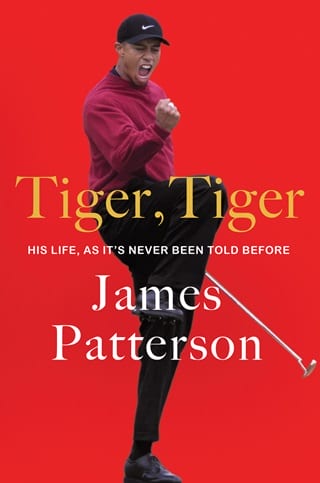Chapter 38
Byron Nelson Golf Classic
TPC Four Seasons Resort
Irving, Texas
May 13–16, 1999
On a perfect spring day, Tiger plays a nearly perfect game. He shoots a first-round 61—including nine birdies and zero bogeys—his lowest-scoring round in a PGA tournament.
According to the Associated Press, the soft greens and sunny, windless sky make for an “easy scoring day in Texas.” Finishing one stroke behind Tiger is Sergio “El Ni?o” Garcia, a nineteen-year-old Spanish golfer who, inspired by five-time major winner Seve Ballesteros, started playing at age three and is making his pro debut in America.
“It’s always fun when you can really get it going like this,” Tiger says.
But that good feeling is one that’s eluded him for the last two years.
Swing coach Butch Harmon has consistently praised Tiger for working “harder than everyone” and using his “tremendous God-given talent” to make “himself better and better.” Still, Tiger’s working through the kinks of his swing change. It’s been a risky choice, especially for a player as gifted as Tiger. According to player-analyst Curtis Strange, “Nothing works like your God-given swing.”
Tiger and Harmon’s painstaking overhaul of the mechanics of his backswing, topswing, and downswing may yet prove Strange wrong. What Tiger’s sacrificed in driving distance—around ten yards—he’s more than gained in precision and ball control.
After signing his first-round scorecard at the Byron Nelson, Tiger places a call to the Butch Harmon School of Golf, at the Rio Secco Golf Club, in Henderson, Nevada.
“Butchie, I got it!” Tiger tells his swing coach. “It’s all starting to feel natural to me.”
The revelation isn’t limited to golf. “I understand how things work now,” he told reporters in a wide-ranging interview last month. “I understand a lot more about the [PGA] Tour, about myself. And it’s a beautiful thing.”
Nike has only one day with Tiger to shoot a commercial at the Orange County National Golf Center and Lodge, in Orlando, Florida. It takes top talent to film top talent. Director Lasse Hallstr?m, whose film credits include What’s Eating Gilbert Grape and the fall release The Cider House Rules, is assisted by director Doug Liman, who directed the 1996 indie hit Swingers and the just-released Go.
The May weather is seasonably hot. The script is simple: A dozen “everyday golfers” on the driving range hit balls—badly—until Tiger appears, upping their games with his presence. The moment Tiger leaves the range, though, they revert to being hackers. But the logistics of a commercial set are complicated, leaving actors and crew standing in the heat for long stretches.
I’m going to try to entertain them, Tiger thinks during a break in the shooting. He picks up his sand wedge and bounces a golf ball, as if it were a Hacky Sack, against the club’s flat surface.
I went over there and just started juggling the ball and doing weird stuff, and they were entertained.
The shoot wraps, but Nike’s looking for more content. “Get something of Tiger after he changed into his spring apparel for an interview with the Golf Channel,” the Nike Golf general manager says to the Nike advertising director, who’s on the set along with executives from Wieden+Kennedy, Nike’s longtime ad agency.
After a quick conference, it’s decided that Tiger’s spontaneous hijinks will be perfect for the second commercial Nike wants. The assistant director, Doug Liman, hoists a camera onto his shoulder as the idea is run by Tiger. He’ll need to keep up the bouncing for twenty-eight continuous seconds (plus the two seconds during which the Nike Golf logo appears on-screen). Not only is Tiger up for the challenge, he also has an idea to raise the degree of difficulty: he’ll end the shot with a final move, swinging his wedge as if it were a baseball bat and smashing the ball.
Tiger’s trick moves dazzle. He switches his club from one hand to the other, moving it behind his back and between his legs, all while keeping the bouncing golf ball aloft. “It’s really not as hard as you might think,” Tiger says. “Hand-to-eye coordination—same principle.”
But he gets annoyed when the ad execs pitch in, counting down the time to Tiger’s swing at the airborne ball and calling out, “OK, you got ten seconds left.”
He shanks it on the first three takes.
“Don’t tell me that,” Tiger finally instructs them. “Just tell me when I’ve got three, four, five seconds. I can switch and end it.”
Liman also decides to fan the flames of Tiger’s competitive instincts. “I can’t believe that of all people you are choking under pressure,” the assistant director says.
A $100 bill is laid atop the camera along with a dare. “Tiger, I bet that you can’t do it on the next one.”
The Wieden+Kennedy creative director, Chuck McBride, gives the cue. The fourth take is live. And it’s perfect.
Tiger pockets his $100 prize and walks off the set.
Chuck McBride sits in a New York City sports bar. It’s mid-June, and the TVs are tuned to the NBA finals—New York Knicks versus San Antonio Spurs—when the “Hacky Sack” Nike commercial airs for the first time.
The noisy bar crowd is stunned into silence as they watch Tiger bounce the golf ball against his clubface. It’s a feat of pure athleticism. And magic. When he drives the airborne ball two hundred yards, the sports fans cheer.
I guess we did something right here, McBride thinks.
“Obviously it was magical,” the Nike Golf general manager says of the unplanned spot.
But is it real? Skeptics say of Nike, “They must have used computer animation or something in that commercial.” To disprove the critics, Nike provides Dateline NBC with outtakes for a TV special about the making of the instantly famous spot.
Its success, says Adweek magazine, lies in reminding people how much they like Tiger: “Here he is as a completely liberated, unfettered talent showing his delightful kind of freaky talent.”
June 20, 1999, is the date of the final round of the U.S. Open at Pinehurst. Steve Williams and Tiger arrange to meet an hour before Tiger’s tee time. The caddie starts to grow concerned when his usually punctual boss is late. Five minutes pass, then ten, with no sign of Tiger at the resort in Pinehurst, North Carolina.
Finally, Tiger’s car pulls into the parking lot. “Sorry I was a bit late,” he says, “but I was watching this cartoon and it was a really good one that I hadn’t seen before.”
The twenty-three-year-old is enthusiastic about cartoons and video games—except when hackers messed with his debut video game, Tiger Woods 99 PGA Tour Golf.
The game, which launched in late 1998, is part of Tiger’s four-year, $10 million deal with the sports division of software developer Electronic Arts, touted as “perhaps the most highly prized deal in the history of the interactive sports industry.” Of the game, which is available in both PC and PlayStation versions, Tiger had proudly announced, “I’ve played video and computer games for many years, but this is the first time I’ve ever been able to say, ‘This is my game.’”
Shortly after its release, however, a listener of WFLZ-FM, in Tampa, Florida, called in to the station’s morning show to report surprising content in the PlayStation version: When the game was played on a computer, an Easter egg featuring a pirated version of the curse-laden 1995 South Park pilot, “The Spirit of Christmas,” appeared as a file choice. An engineer was ultimately found responsible for what EA described as “an unfortunate and odd thing” that forced the company to recall the first one hundred thousand copies of the game. But if anything, it goosed interest.
Excitement about Tiger’s chances at the U.S. Open have also been goosed. After essentially hitting a Pause button of sorts over the last eighteen months while he’s reworked his swing, Tiger has been putting better than ever, in part thanks to a heart-to-heart with Earl about technique that resulted in Tiger’s returning, as he tells reporters, “to some of the fundamentals that I used to do as a kid.”
“Absolutely [Tiger] can win the U.S. Open,” says Mark O’Meara.
But no one’s counting out Payne Stewart, who won his first U.S. Open in 1991 and who’s recently returned to championship form. “Total flowing swing,” NBC’s lead golf announcer, Johnny Miller, says admiringly. “That does not look like a guy in his forties. That swing might last awhile.”
Caddie Steve Williams focuses on Tiger, stating, “Starting the day two strokes behind Payne Stewart, this was a tournament he had a chance to win.”
Early on the back nine, Phil Mickelson (who placed fifty-fifth at the U.S. Open in 1991) is tied with Stewart for the lead at Pinehurst, a course dating to 1895 and known as the Cradle of American Golf. The name seems especially apt today. Mickelson’s carrying a beeper to alert him in case his wife, Amy, goes into labor with their first child.
Play continues through a steady drizzle. On 16, Stewart astonishes the crowd when he saves par with a double-breaking twenty-five-foot downhill putt. When Mickelson misses his own par putt, the two are tied for the lead. Both hit the green on the par-three 17th, Mickelson just six feet from the pin, Stewart even closer at four feet.
The gallery erupts in ground-shaking noise the scorer likens to “a small earthquake,” so tumultuous that it delays Tiger’s reset from bogeying 17 to driving on 18.
Making one final par putt on the 72nd hole would clinch a second U.S. Open championship for Stewart.
He lines up a fifteen-footer but initially can’t bring himself to look up and actually watch the ball he’s just hit until, he says, “it was about 2 feet away from the hole and breaking right into the center of the cup. I couldn’t believe my eyes. I couldn’t believe I had accomplished my dream.”
Tiger, who ties with Vijay Singh for third (both 281 to Stewart’s 279 and Mickelson’s 280), notes, “I’m glad he made that putt on 18 because I’ll be sleeping a little bit better tonight.”
A full-scale celebration is happening on the green. Stewart’s caddie, Mike Hicks, leaps into his player’s arms. Stewart sheds joyful tears over his win and offers fond wishes to Mickelson, cupping the runner-up’s face in both hands and saying, “Good luck with the baby. There’s nothing like being a father.”
 Fullepub
Fullepub 



